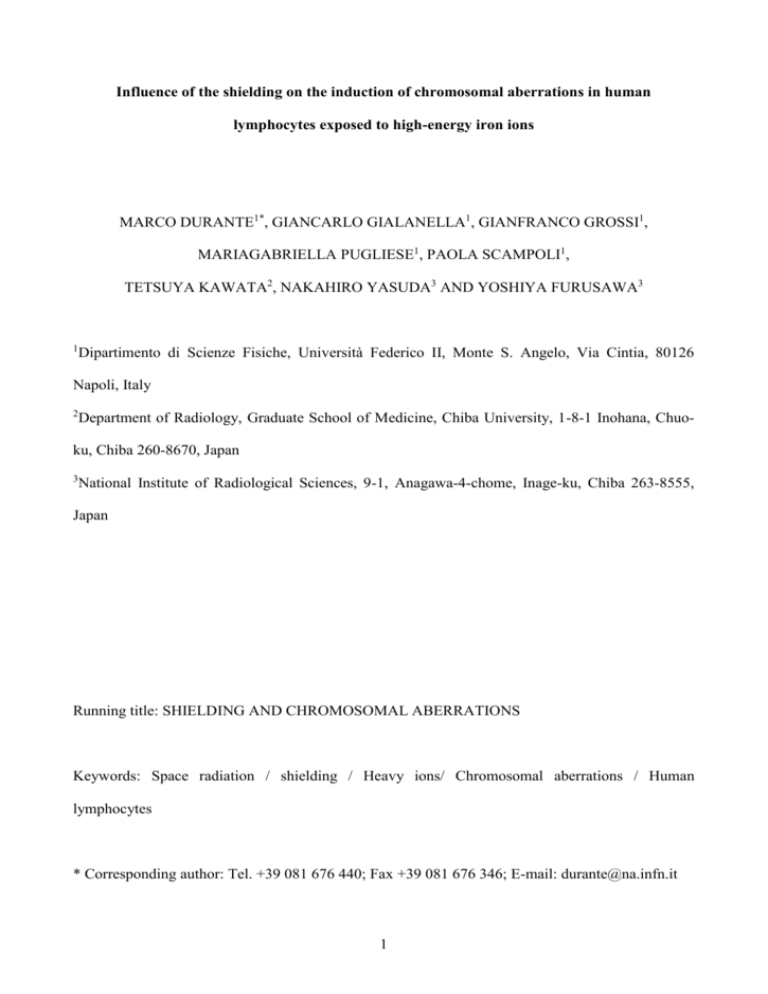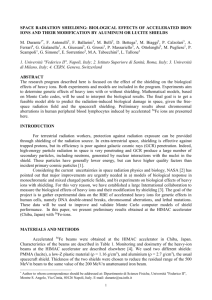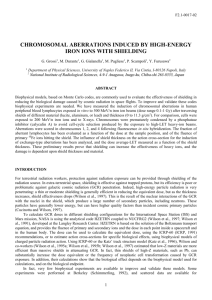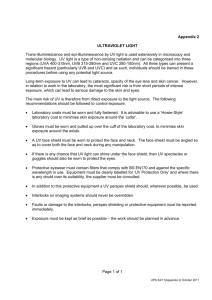Influence of the shielding on the space radiation biological
advertisement

Influence of the shielding on the induction of chromosomal aberrations in human lymphocytes exposed to high-energy iron ions MARCO DURANTE1*, GIANCARLO GIALANELLA1, GIANFRANCO GROSSI1, MARIAGABRIELLA PUGLIESE1, PAOLA SCAMPOLI1, TETSUYA KAWATA2, NAKAHIRO YASUDA3 AND YOSHIYA FURUSAWA3 1 Dipartimento di Scienze Fisiche, Università Federico II, Monte S. Angelo, Via Cintia, 80126 Napoli, Italy 2 Department of Radiology, Graduate School of Medicine, Chiba University, 1-8-1 Inohana, Chuo- ku, Chiba 260-8670, Japan 3 National Institute of Radiological Sciences, 9-1, Anagawa-4-chome, Inage-ku, Chiba 263-8555, Japan Running title: SHIELDING AND CHROMOSOMAL ABERRATIONS Keywords: Space radiation / shielding / Heavy ions/ Chromosomal aberrations / Human lymphocytes * Corresponding author: Tel. +39 081 676 440; Fax +39 081 676 346; E-mail: durante@na.infn.it 1 ABSTRACT Computer code calculations based on biophysical models are commonly used to evaluate the effectiveness of shielding in reducing the biological damage caused by cosmic radiation in space flights. Biological measurements are urgently needed to benchmark the codes. We have measured the induction of chromosomal aberrations in human peripheral blood lymphocytes exposed in vitro to 56 Fe-ion beams accelerated at the HIMAC synchrotron in Chiba. Isolated lymphocytes were exposed to the 500 MeV/n iron beam (dose range 0.1-1 Gy) after traversal of 0 to 8 g/cm2 of either PMMA (lucite, a common plastic material) or aluminum. Three PMMA shield thickness and one Al shield thickness were used. For comparison, cells were exposed to 200 MeV/n iron ions and to Xrays. Chromosomes were prematurely condensed by a phosphatase inhibitor (calyculin A) to avoid cell-cycle selection produced by the exposure to high-LET heavy ion beams. Aberrations were scored in chromosomes 1, 2, and 4 following fluorescence in situ hybridization. The yield of chromosomal aberrations per unit dose at the sample position was poorly dependent on the shield thickness and material. However, the yield of aberrations per unit ion incident on the shield was increased by the shielding. This increase is associated to the increased dose-rate measured behind the shield as compared to the direct beam. These preliminary results prove that shielding can increase the effectiveness of heavy ions, and the damage is dependent upon shield thickness and material. 2 INTRODUCTION For terrestrial radiation workers, additional protection against radiation exposure is usually provided through increased shielding. Unfortunately, shielding in space is problematic, especially when galactic cosmic radiation (GCR) is considered. High-energy radiation is very penetrating: a thin or moderate shielding is generally efficient in reducing the equivalent dose, but as the thickness increases, shield effectiveness drops 1). This is the result of the production of a large number of secondary particles, including neutrons, caused by nuclear interactions of the GCR with the shield. These particles have generally lower energy, but can have higher quality factors than incident cosmic primary particles. NASA is using the analytical code HZETRN coupled to NUCFRG2 1, 2) , developed at the Langley Research Center, to calculate GCR doses in different shielding configurations for the International Space Station (ISS) and Mars mission. HZETRN is based on the solution of the Boltzmann transport equation, and provides the fluence of primary and secondary ions and the dose in each point inside a spacecraft and in the human body. The dose can be used to calculate the equivalent dose, using the ICRP-60 3) recommendations, or to estimate action cross-sections for specific biological effects, using biophysical models of charged particle radiation action. Using ICRP-60 or the Katz’ track structure model 4), Wilson and co-workers 1, 5, 6) estimated that low-Z materials are more efficient than massive shields in attenuating GCR. In fact, thin shields of high-Z materials, such as Pb, can substantially increase the dose equivalent or the frequency of neoplastic cell transformation caused by GCR exposure. In addition, their calculations show that the biological effect depends on the biophysical model used for calculations, and on the biological endpoint. Unfortunately, very few biological experiments are available to validate these models. Some experiments were performed at Berkeley 7), and scattered data are available for cataractogenesis and chromosome aberrations 8) 9) . For these very reasons, a large international collaboration (involving Italian, US, and Japanese groups) is now measuring different biological endpoints in 3 human cells exposed to heavy ions with or without shielding of different materials 10, 11) . In this paper, we measured the induction of chromosomal aberrations in human peripheral blood lymphocytes exposed to accelerated iron ions with shields in PMMA or aluminum. Chromosomal aberrations are considered a reliable biomarker of radiation-induced stochastic effects surprisingly, the National Academy of Sciences 15) 12, 13, 14) . Not has identified as an important research issue to be urgently addressed the measurement of cell killing and chromosomal aberrations as a function of thickness and composition of the shielding. Data relative to DNA damage 16) and cell killing 17) are given in other papers in this same journal issue. MATERIALS AND METHODS Irradiation Blood was drawn in a Vacutainer CPT (Beckton-Dickinson, Lincoln Park, USA) from a male 40-years old volunteer. Blood cells were centrifuged 30 min at 3000 rpm, washed twice in PBS, resuspended in RPMI-1640 medium (Gibco-BRL, Grand Island, NY) supplemented with 20% serum, and finally loaded by a syringe into specially constructed 1 ml PMMA (lucite) holders. Both the loading chamber and the holder wall exposed to the beam were 1 mm thick. Cells were exposed in air at room temperature. Doses measured at the sample position by ionization chambers ranged from 0.1 Gy to 1 Gy. The shield material was attached to the blood holder wall exposed to the beam, so that secondary fragments emitted at large angles in the laboratory are hitting the biological target. Physical characteristics of the iron beams used at the HIMAC in the experiments described here are given in Table 1. The energy in vacuum is different from the energy of the beam at the sample position, because of the detectors used on the line to monitor the beam, exit windows and air. The fluence of heavy particles incident on the shield was measured by CR-39 plastic nuclear track detectors attached to the shield and facing the beam. The irradiated plastics were etched in 7N 4 NaOH for 1-11 h. Results of fluence measurements by nuclear track detectors were consistent with the data of the monitor ionization chambers. CR-39 were also used to obtain the fraction of primary ions in the beam at the sample position. Track-diameter distribution were measured for CR39 plastics exposed at the sample position, as shown in Fig. 1. The ratio primary/secondary ions is evaluated from data in Fig. 1 as the ratio k between counts in the peak and at sizes smaller than the peak. The small peaks correspond to ions with 3<Z<26. Indeed, under our experimental conditions ions with Z≤3 cannot be detected. The fraction S of surviving Fe-ions at the sample position is finally evaluated as S=kFb/Fa, where Fa is the fluence of particle on the shield (primaries only) and Fb the fluence at the sample position (all ions). Chromosome aberration analysis To avoid the cell-cycle selection in the harvested cell population produced by the exposure to high-LET radiation, we elected to use the novel technique of premature chromosome condensation with phosphatase inhibitors (calyculin A) to visualize the chromosomes in different stages of the cell-cycle 18, 19, 20). Immediately after exposure, cells were transferred in tissue culture flasks in RPMI-1640 medium supplemented with 20% serum and 2% phytohaemmaglutinin. Flasks were incubated in vertical position for 48 h at 37 °C. Calyculin A (Wako chemicals, Japan) at a final concentration of 50 nM was then added for 1 h, and cells containing prematurely condensed chromosomes in G1, S, G2, and M-phase were harvested as previously described 21) . Slides were hybridized in situ with whole-chromosome DNA probes (Vysis, Downers Grove, IL) specific for human chromosomes 1, 2, and 4, and visualized at an epi-fluorescent microscope. All kinds of chromosomal aberrations (dicentrics, translocations, complex-type exchanges, rings, acentric fragments) were scored separately in samples ranging from 150 to 3000 cells (mostly G2- and Mphases) per dose. However, in the figures we plot the yield of total exchanges in the painted genome, i.e. the sum of simple and complex interchanges (both complete and incomplete) involving 5 chromosomes 1, 2, and 4. The total yield of aberrations has a better statistics than individual aberration yields. RESULTS AND DISCUSSION The total yield of chromosomal exchanges in chromosomes 1, 2, and 4 is plotted in Fig. 2 as a function of the dose at the sample position or vs. the fluence of iron ions incident on the shield. In Fig. 2a, the yield of aberrations induced by the 500 MeV/n and 200 MeV/n unshielded iron beams is compared to X-rays and to the 500 MeV/n beam after 30 mm Al shield in the same dose-range (0.1-1 Gy). All particle beams are more efficient per unit dose than X-rays. The Al shield slightly reduces the effectiveness of the 500 MeV/n beam per gray. Although the shielded beam has the same residual range as the 200 MeV/n Fe beam (Table 1), it is clearly more effective per unit dose than the unshielded low-energy beam. From CR-39 measurements, we found that only 46% of the primary Fe ions hitting the shield are actually found at the sample position. When the Al shield was added in front of the sample, the dose-rate at the sample position had about a 70% increase. The dose-average LET (including secondary particles) after the Al shield was indeed increased from 200 keV/m (unshielded beam) to around 400 keV/m. The dose per primary Fe ion incident on the shield is then increased behind the Al block. As a result, the efficiency per incident particle is the highest for the 500 MeV/n beam shielded in Al (Fig. 2b). It is also observed that the efficiency per particle of the unshielded 500 MeV/n and 200 MeV/n is similar, showing that the action crosssection for the induction of chromosome aberrations is saturated at these high LET values. The effect of different thickness of PMMA (lucite) on the effectiveness of the 500 MeV/n iron beam is shown in Fig. 3. Fluence-response curves (such as those in Fig. 2b) appeared to be linear in the measured dose-range, and were fitted by the function: Y=F, where Y is the frequency of exchanges in the painted genome (chromosomes 1, 2, and 4) per lymphocyte, F is the fluence (in particles/m2) of iron ions hitting the lucite shield (from 0 to 56 mm thick), and is the action 6 cross-section for the induction of exchange-type aberrations. The action cross section represents the product of the cross-sectional area of the sensitive target and the probability of aberration induction per ion hit on the shielding. Clearly, the cross-section increases by increasing the shield thickness in this range. The increase appears to be caused by the same physical process described for the Al shield, i.e. the increased dose-rate induced by the shield. The results clearly show that shielding can increase the effectiveness of heavy ions, as predicted by Wilson and co-workers 1, 5, 6) for the GCR. The increase in biological effectiveness appears to reflect the increase in dose-rate behind the shield. The situation appears to be different for 1 GeV/n iron beams, where the dose-rate is reduced behind thick shield, as discussed in the paper about the DNA damage in the framework of this same collaboration 16). More experiments on chromosomal aberrations are under way both at the HIMAC and at the AGS of the Brookhaven National Laboratory. Hopefully, a substantially amount of biological data will be soon available to benchmark the computer codes and biophysical models used to evaluate the shielding in space. ACKNOWLEDGEMENTS This research project is funded by the Italian Space Agency (ASI). The authors are grateful to the crew of the HIMAC Accelerator for their skillful technical assistance during irradiations. We also thank Dr. T. Kanai for information about the dose-average LET after the shield, and Dr. F.A. Cucinotta for useful suggestions about this research project. REFERENCES 1) Wilson, J.W., Konradi, A., Miller, J. and Cucinotta, F. A. (1997) Shielding strategies for human space exploration. NASA CP-3360, Springfield, VA. 7 2) Wilson, J.W., Townsend, L.W., Schimmerling, W., Khandelwal, G.S., Khan, F., Nealy, J.E., Cucinotta, F.A., Simonsen, L.C., Shinn, J.L. and Norbury, J.W. (1991) Transport methods and interactions for space radiations. NASA RP-1257, Springfield, VA. 3) ICRP (1991) Recommendations of the International Commission on Radiological Protection. Annals of the ICRP 21, Publication 60. Pergamon Press, Oxford. 4) Katz, R., Cucinotta, F.A. and Zhang, C.X. (1996) The calculation of radial dose from heavy ions: predictions of biological action cross sections. Nucl. Instr. Meth. B107, 287-291. 5) Wilson, J.W., Kim, M., Schimmerling, W., Badavi, F.F., Thibeault, S.A., Cucinotta, F.A., Shinn, J.L. and Kiefer, R. (1995) Issues in space radiation protection: galactic cosmic rays. Health Phys. 68, 50-58. 6) Wilson, J.W., Thibeault, S.A., Cucinotta, F.A., Shinn, J.L., Kim, M., Kiefer, R. and Badavi, F.F. (1995) Issues in protection from galactic cosmic rays. Radiat. Environ. Biophys. 34, 217-222. 7) Schimmerling, W. (1992) Ground-based measurements of galactic cosmic ray fragmentation in shielding. Adv. Space Res. 12, 445-459. 8) Medvedovsky, C., Worgul, B.V., Huang, Y., Brenner, D.J., Tao, F., Miller, J., Zeitlin, C. and Ainsworth, E.J. (1994) The influence of dose, dose-rate and particle fragmentation on cataract induction by energetic iron ions. Adv. Space Res. 14, 475-482. 9) Yang, T.C., George, K., Wu, H., Miller, D. and Miller, J. (1998) Cytogenetic effects of energetic ions with shielding. Adv. Space Res. 22, 1683-1690. 10) Durante, M. (2001) Influence of the shielding on the space radiation biological effectiveness. Phys. Med. 17, S269-S271. 11) Durante, M. (2000) Italian Space Radiobiology Program: influence of the shielding on the biological effects of heavy ions. In: Exploring Future Research Strategies in Space Radiation Sciences, Eds. H. Majima and K. Fujitaka, pp.79-85, Iryokagakusha, Tokyo. 8 12) Bonassi, S., Hagmar, L., Stromberg, U., Montagud, A.H., Tinnerberg, H., Forni, A., Heikkila, P., Wanders, S., Wilhardt, P., Hansteen, I.L., Knudsen L.E. and Norppa, H. (2000) Chromosomal aberrations in lymphocytes predict human cancer independently of exposure to carcinogens. Cancer. Res. 60, 1619-1625. 13) Kodama, Y., Pawel, D., Nakamura, N., Preston, D., Honda, T., Itoh, M., Nakano, M., Ohtaki, K., Funamoto, S. and Awa, A.A. (2001) Stable chromosome aberrations in atomic bomb survivors: results from 25 years of investigation. Radiat. Res. 156, 337-346. 14) Durante, M., Bonassi, S., George, K. and Cucinotta, F.A. (2001) Risk estimation based on chromosomal aberrations induced by radiation. Radiat. Res. 156, 662-667. 15) National Academy of Sciences (1997) Radiation Hazards to Crews on Interplanetary Missions. Report of the Task Group on the Biological Effects of Space Radiation. National Academy Press, Washington DC. 16) Antonelli, F., Belli, M., Dini, V., Durante, M., Furusawa, Y., Rydberg, B., Simone, G., Sorrentino, E. and Tabocchini, M.A. (2002) Influence of the shielding on the space radiation biological effectiveness. I. DNA damage. J. Radiat. Res., this issue. 17) Bettega, D., Calzolari, P., Massariello, P., Belloni, F., Durante, M., Tallone, L. and Furusawa, Y. (2002) Influence of the shielding on the space radiation biological effectiveness. III. Delayed reproductive death. J. Radiat. Res., this issue. 18) Durante, M., Furusawa, Y., Majima, H., Kawata, T. and Gotoh, E. (1999) Association beteween G2-phase block and repair of radiation-induced chromosome fragments in human lymphocytes. Radiat. Res. 151, 670-676. 19) Sasaki, M. S., Hayata, I., Kamada, N., Kodama, Y. and Kodama, S. (2001) Chromosome aberration analysis in persons exposed to low-level radiation from the JCO criticality accident in Tokai-mura. J. Radiat. Res. 42, S107-S116. 9 20) Hayata, I., Kanda, R., Minamihisamatsu, M., Furukawa, A. and Sasaki, M.S. (2001) Cytogenetical dose estimation for 3 severely exposed patients in the JCO criticality accident in Tokai-mura. J. Radiat. Res. 42, S149-S155. 21) Durante, M., Furusawa, Y. and Gotoh, E. (1998) A simple method for simultaneous interphase-metaphase chromosome analysis in biological dosimetry. Int. J. Radiat. Biol. 74, 457-462. 10 Table 1. Physical characteristics of the iron beams used at the HIMAC accelerator. Fluence in the last column provides the numer of 56Fe ions per unit area incident on the shield to get a dose of 1 Gy at the sample position. Energy in Energy on vacuum (MeV/n) Shield Thickness Residual Dose- Fluence on sample in mm range in average the shield (MeV/n) (g/cm2) H2O (mm) LET (particles· (keV/m) cm-2·Gy-1· 106) 500 414 - - 71.6 200 3.12 500 - Al 30 (8.1) 8.0 378 1.82 500 - PMMA 23 (2.76) 56.5 221 2.97 500 - PMMA 43 (5.16) 24.1 268 2.57 500 - PMMA 56 (6.72) 8.0 394 1.78 200 115 - - 8.03 442 1.51 11 Figure captions Figure 1. Etched-track size-distribution in CR39 exposed at the sample position to 500 MeV/n Fe-beam shielded with either 56 mm PMMA (top panel) or 30 mm Al (bottom panel). The large peak for a semi-axis around 38 m corresponds to primary Fe-ions transmitted through the shielding. Smaller tracks are produced by light fragments with 3<Z<26 produced by the targetprojectile interaction. Figure 2. Frequency of total exchanges (simple-type plus complex-type, both reciprocal and incomplete) involving prematurely condensed human chromosomes 1, 2, and 4 in blood lymphocytes exposed to accelerated iron ions, plotted vs. a) the dose at the sample position; and b) the fluence of iron ions incident on the shield. The shield thickness is 0 mm for (о) and (□), or 3 cm Al for (◊). X-ray data are shown for comparison in panel (a). Bars are standard errors of the mean values. Physical characteristics of the beams are provided in Table 1. Figure 3. Action cross-section for the induction of total exchanges involving prematurely condensed human chromosomes 1, 2, and 4 in blood lymphocytes exposed to 500 MeV/n 56 Fe ions attenuated with different thickness of PMMA. Bars are standard errors of the mean values. The line is an interpolation of the data points. 12 Figure 1 13 Total exchanges in chromosomes 1,2, and 4 per cell 0.3 a b 0.25 500 MeV/n 200 MeV/n 500 MeV/n + 3 cm Al X-rays 0.2 0.15 0.1 0.05 0 0 20 40 60 80 100 0 0.5 1 1.5 2 2.5 2 Fluence (particles/cm ) x10 Dose (cGy) 14 6 3 3.5 14 2 Cross-section ( m ) 13 12 11 10 9 8 7 0 1 2 3 6 5 4 2 PMMA thickness (g/cm ) Figure 3. 15 7









